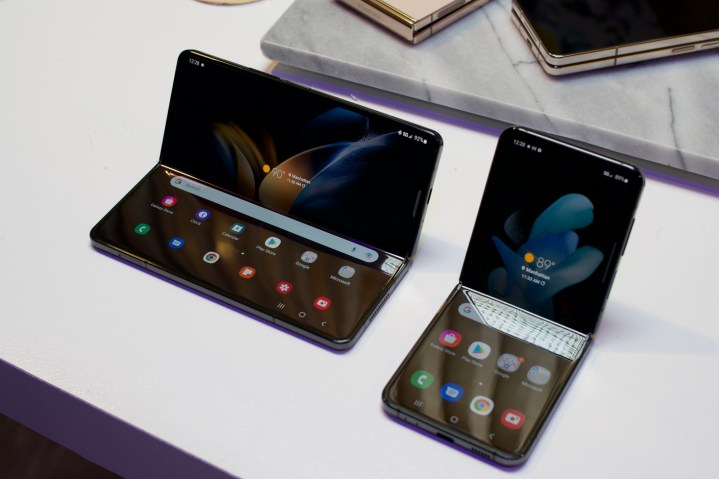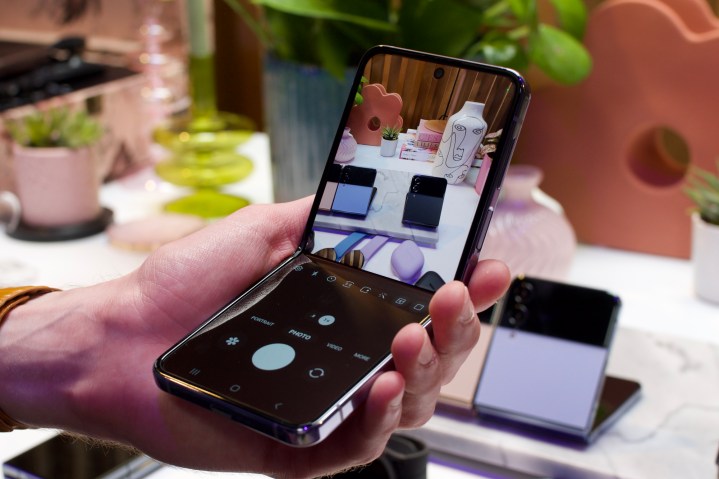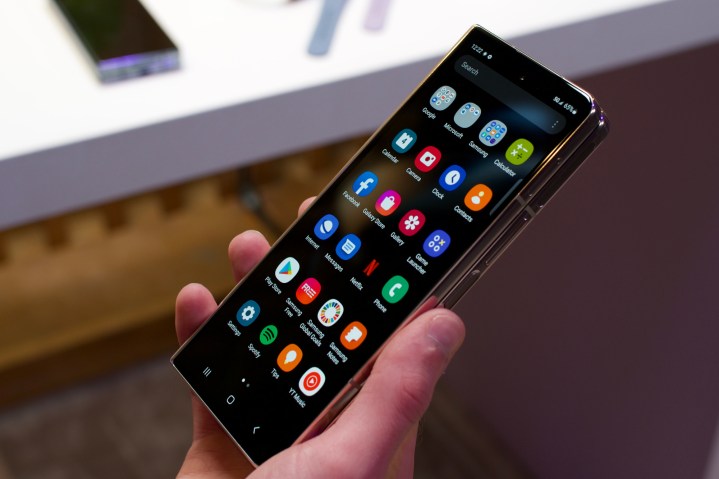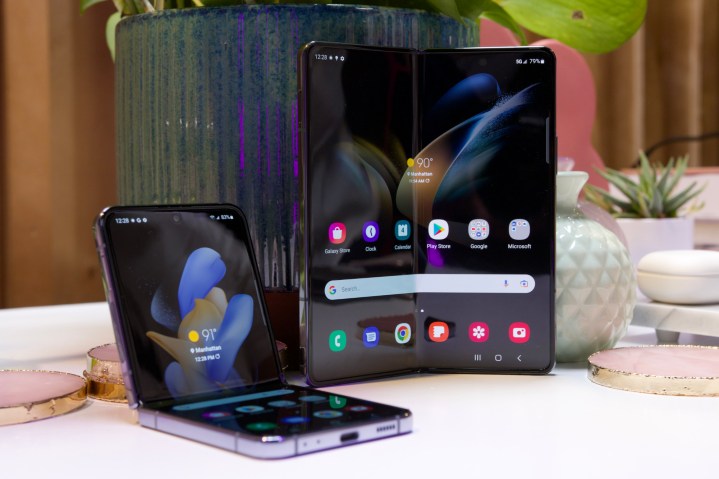They may still seem like a novel concept, but foldable phones have already come a long way. When Samsung released its first foldable — the Samsung Galaxy Fold — in fall 2019, it suffered from a number of problems, including concerns about its durability and its impractically small front screen. Now, the device is into its fourth generation, with the South Korean tech giant revealing the Galaxy Z Fold 4 and its sibling, the Galaxy Z Flip 4, as part of its Galaxy Unpacked event. Both devices show just how much Samsung has refined the foldable phone concept, with each boasting more durable screens, enhanced processors, and software that takes fuller advantage of each mobile’s foldability.
Anyone new to folding phones may be wondering which of Samsung’s two devices is better for them. That’s where this head-to-head comparison comes in, with each device being put through its paces and evaluated according to its specs, performance, design, display, battery, cameras, and software. By weighing up each phone against the other, it should help you decide which way to go.
Specs
| Samsung Galaxy Z Fold 4 |
Samsung Galaxy Z Flip 4 |
|
| Size | Unfolded: 130.1 x 155.1 x 6.3mm
Folded: 67.1 x 155.1 x 15.8mm |
Unfolded: 71.9 x 165.2 x 6.9mm
Folded: 71.9 x 84.9 x 17.1mm |
| Weight | 263 grams | 187 grams |
| Screen size | Main: 7.6-inch Dynamic AMOLED 2X
Cover screen: 6.2-inch Dynamic AMOLED 2X |
Main: 6.7-inch Dynamic AMOLED 2X
Cover screen: 1.9-inch Super AMOLED |
| Screen resolution | Main: 2176 x 1812 pixels (372 pixels per inch)
Cover screen: 2268 x 832 pixels (387 ppi) |
Main: 2640 x 1080 pixels (426 pixels per inch)
Cover screen: 512 x 260 pixels (302 ppi) |
| Operating system | Android 12 with One UI 4.1 | Android 12 with One UI 4.1 |
| Storage | 256GB, 512GB, 1TB | 128GB, 256GB, 512GB |
| MicroSD card slot | No | No |
| Tap-to-pay services | Google Pay, Samsung Pay | Google Pay, Samsung Pay |
| Processor | Qualcomm Snapdragon 8+ Gen 1 | Qualcomm Snapdragon 8+ Gen 1 |
| RAM | 12GB | 8GB |
| Camera | Rear main: 50MP primary, 12MP ultrawide, and 10MP telephoto
Front main screen: 4MP under-display Cover screen: 10MP |
Rear main: 12MP primary, 12MP ultrawide
Front: 10MP |
| Video | 4K at 60 frames per second, 1080p at 240 fps, 720p at 960 fps, HDR10+ | 4K at 60 fps, 1080p at 240 fps, 720p at 960 fps, HDR10+ |
| Bluetooth version | 5.2 | 5.2 |
| Ports | USB-C | USB-C |
| Fingerprint sensor | Yes, side-mounted | Yes, side-mounted |
| Water resistance | IPX8 | IPX8 |
| Battery | 4,400mAh
25W wired charging 10W wireless charging 4.5W reverse wireless charging |
3,700mAh
25W wired charging 10W wireless charging 4.5W reverse wireless charging |
| App marketplace | Google Play Store | Google Play Store |
| Network support | All carriers | All carriers |
| Colors | Graygreen, Phantom Black, Beige, Burgundy (Samsung Exclusive) | Bora Purple, Graphite, Pink Gold, Blue |
| Prices | $1,800 | $1,000 |
| Buy from | Samsung | Samsung |
| Review | Galaxy Z Fold 4 review | Galaxy Z Flip 4 review |
Design, display, and durability

Neither the Samsung Galaxy Z Fold 4 nor the Galaxy Z Flip 4 are a major departure from the designs of their respective predecessors, but they vary from each other in important ways. The Fold 4 is the bigger sibling of the pair, featuring a 7.6-inch AMOLED 2X display when unfolded, giving it a much larger width than the Flip 4. However, the Fold is fractionally smaller than its predecessor, the Z Fold 3, as well as nearly 10 grams lighter, making it a bit more comfortable than the older model.
In terms of which foldable is more aesthetically pleasing, it really depends on your tastes. Some will undoubtedly prefer the sleek minimalism of the Z Flip 4, which folds in half and reduces in length to 71.9mm (2.83 inches), making it conveniently pocket-sized. On the other hand, the sheer size of the Z Fold 4 will also attract its own converts, who will prefer the ability to transform their smartphone into a tablet with an impressively vivid — and large — screen.
Speaking of displays, the Fold 4’s main 7.6-inch Dynamic AMOLED 2X display has a resolution of 2176 x 1812 pixels, working out at 372 pixels per inch. This contrasts with the Flip 4’s main display, which at 2640 x 1080 pixels, has a density of 426 ppi. Both of these displays support an adaptive refresh rate of up to 120Hz, making for some very smooth scrolling and animations. So while the Z Fold 4 may be more immediately impressive due to the greater size of its unfolded (i.e. opened up) main display, the Z Flip 4 also has a supremely rich screen.

One difference, however, is that the Fold 4’s cover/front screen — a 6.2-inch Dynamic AMOLED 2X panel — is more impressive than its counterpart on the Flip 4, which happens to be a 1.9-inch Super AMOLED display with a resolution of only
260 x 512 pixels (compared to 2316 x 904 pixels for the Fold). As with the Z Flip 3, its functions will be relatively limited in comparison to those of the Fold 4’s cover screen, while it obviously isn’t as clear or as sharp. To be fair, this isn’t surprising, but it nonetheless marks the Z Flip 4 down on the display front in relation to the Z Fold 4.
Turning to durability, both devices are basically equal. They both feature an IPX8 rating for water resistance, as well as Armor Aluminum frames and Gorilla Glass Victus+ on their rears and displays. This makes them very robust, and while some would prefer the bigger dimensions of the Fold, the superior portability of the Flip rebalances things in this round, resulting in a tie.
Winner: Tie
Performance, battery life, and charging

Both foldables are powered by the Qualcomm Snapdragon 8+ Gen 1, a chip made using a 4nm manufacturing process, making it faster than previous generations. The Z Fold 4 packs 12GB of RAM, while the Z Flip 4 has 8GB. In theory, this would result in the Fold outperforming the Flip. If you plan on doing a lot of multitasking and running multiple apps at once – something the Fold is naturally suited for — it’ll be the better choice here.
Looking at storage, the Fold 4 offers 256GB of memory as standard and can be had with either 512GB or 1TB. The Flip 4, by contrast, starts with 128GB and can go up to 512GB. Neither device has a slot for a microSD card. It’s disappointing, but with storage options going up to 512GB or 1TB, you probably wouldn’t notice the absence.
The Z Fold 4 comes with 4,400mAh battery while the Z Flip has a 3,700mAh equivalent, yet in practice, you’re going to get a similar life span from both. That’s because the Fold is considerably bigger than its stablemate, with two larger screens to feed.
As such, you’re likely to need a recharge by the end of the day with both, something that has been confirmed by our reviews for the Fold and the Flip. Of course, you could make the Fold last longer by using it only for basic phone stuff (and not for multitasking), but that kind of defeats its purpose. Still, with superior computing performance, it wins this round.
Winner: Samsung Galaxy Z Fold 4
Camera

The Z Fold 4 and Z Flip 4 bear some noticeable differences in the camera department. The Flip 4 has a 10MP selfie camera and a pair of 12MP lenses (wide and ultrawide) on the rear. Meanwhile, the Fold has a triple-lens rear camera setup, with a 50MP main lens, a 12MP ultrawide, and a 10MP telephoto. You also get a 10MP selfie camera on its cover display, plus a 4MP camera under its main 7.6-inch display.
The Fold’s triple-lens rear camera setup provides it with greater versatility, while its 50MP main lens offers an improvement over the 12MP main lens on the Fold 3. It also offers an improvement over the 12MP main lens on theFlip 4, which can take some excellent photos in good conditions, but may struggle with overprocessing and saturation on occasion (as was the case with its predecessor). On top of this, the 10MP telephoto lens on Fold 4 is genuinely usable, providing solid clarity and proving highly useful in situations where you can’t physically move close enough to your subject.
Indeed, our review of the Fold 4 revealed that it’s definitely one of the most versatile and dependable camera phones out there right now, so it takes this round comfortably.
Winner: Samsung Galaxy Z Fold 4
Software and updates

Both phones run One UI 4.1, Samsung’s skin of Android 12. While there are a few subtle variations between each device’s implementation of One UI 4, the basic experience is essentially the same. That means you get a customizable and high-performing version of Android, replete with an enhanced privacy dashboard and a Stories feature in the Gallery app that compiles your best photos.
When it comes to updates, both devices are likely to be bumped up to Android 13 — and subsequent versions — around the same time. Like the Z Fold 3 and Z Flip 3 before them, we expect the Z Fold 4 and Z Flip 4 to receive Samsung’s standard update policy. That means four major Android updates and five years of security patches.
Winner: Tie
Special features

Aside from the obvious ability to fold, both the Fold 4 and the Flip 4 offer a range of special features. They each support 5G, while the Flip 4 offers Flex Mode, which enables hands-free photos and video streaming while the phone is folded shut.
As for the Fold 4, it has been optimized even further for multitasking than the Fold 3. It includes a new Windows-style taskbar at the bottom of its main display, making it more useful from a productivity standpoint. Users can also have three apps open and share the main screen at once, while a fourth app can be opened to float over them. The Fold 4 also works with the S Pen, turning it into a mobile powerhouse for drawing and note-taking. All of this makes the Fold much more useful for professionals than the average smartphone, and this is why it takes a narrow win over the Z Flip 4 in this round.
Winner: Samsung Galaxy Z Fold 4
Price and availability
The Samsung Galaxy Z Fold 4 is available from Samsung, with prices starting at $1,800 for the base model, the same as with the Fold 3. It’s supported by all major carriers and by most major retailers.
Also available from Samsung, the Galaxy Z Flip 4 starts at $1,000, with prices rising for models with 256GB or 512GB of internal memory. Again, it’s supported by all major networks and sold widely by third parties.
Overall winner: Samsung Galaxy Z Fold 4

Both foldables have their own respective merits, but the Galaxy Z Fold 4 edges the Z Flip 4 out by virtue of slightly better performance, more memory, a superior and highly versatile camera, and more multitasking potential. It also arguably has a more impressive display, which, when unfolded/opened, effectively turns it into a tablet. It’s expensive, yes, but the sheer functionality provided by the Fold 4 is difficult to ignore.
But that’s not to say the Flip 4 should be forgotten. If you’re interested in a foldable but can’t stomach the Fold 4’s price (or simply don’t like its design), the Flip 4 is an excellent foldable alternative. It’s not quite as functional or robust, but it’s absolutely worth keeping on your shortlist.
Editors' Recommendations
- 5 phones you should buy instead of the Samsung Galaxy S24 Plus
- The Galaxy Z Fold 6 and Flip 6 release date just leaked
- Samsung Galaxy S24 vs. Galaxy S22: Do you really need to upgrade?
- This deal gets you a box-fresh Samsung Galaxy Watch from $99
- Best Samsung Galaxy Z Flip 5 deals: Get the foldable for free



